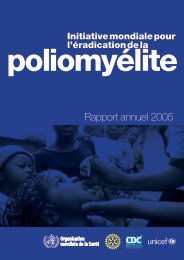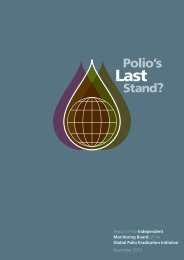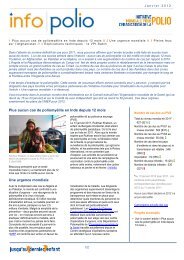(EAP) 2012-2013 - Global Polio Eradication Initiative
(EAP) 2012-2013 - Global Polio Eradication Initiative
(EAP) 2012-2013 - Global Polio Eradication Initiative
You also want an ePaper? Increase the reach of your titles
YUMPU automatically turns print PDFs into web optimized ePapers that Google loves.
16 global <strong>Polio</strong> emergency action Plan <strong>2012</strong>-13<br />
Pakistan<br />
situational Analysis<br />
polio cases, 2011 198.cases.(196.WPV1.and.2.WPV3) 40% increase in<br />
worst performing areas,2011 Baluchistan,.FATA.and.Karachi<br />
wpV cases<br />
compared to 2010<br />
It is continued transmission in these areas that threatens<br />
the achievement of polio eradication in Pakistan.<br />
Children are being missed during immunization activities<br />
because of a range of operational and social factors,<br />
and in some areas due to ongoing insecurity (although<br />
access to children in FATA has improved significantly<br />
in Q4 2011/Q1 <strong>2012</strong>).<br />
Programme performance is complicated further by the<br />
presence of minority groups in some of the key zones,<br />
including in Karachi and Quetta block, which require<br />
special strategies to be reached. Achieving well-supervised,<br />
high-quality immunization rounds in the key<br />
transmission zones remains the major issue for the programme<br />
in Pakistan.<br />
However, despite these very real challenges, there have<br />
been several encouraging developments in the national<br />
programme over the last six months particularly in the<br />
areas of programme oversight and accountability at district/agency<br />
level (with District Coordination Officers<br />
now being held directly accountable and in turn holding<br />
health authorities accountable); the ongoing scaleup<br />
of technical assistance to the subdistrict level by UN<br />
agencies, particularly in the worst-performing areas of<br />
Karachi and the Quetta block; and tighter programme<br />
Action to stop polio now in nigeriA, pAkistAn And AfghAnistAn<br />
In 2011 Pakistan reported 198 cases due to wild<br />
poliovirus (196 due to WPV1 and two due to<br />
WPV3), an increase of nearly 40% compared with<br />
2010. In the first half of the year transmission was<br />
heavily concentrated in the known, poor-performing<br />
transmission zones in Baluchistan, FATA, and<br />
Karachi, but during the high transmission season<br />
virus spread more widely out of these zones,<br />
including into areas that had been polio-free.<br />
Nonetheless the worst- performing areas, which have<br />
been identified by the national programme for several<br />
years now, carry by far the largest burden of disease.<br />
performance monitoring, with campaigns being suspended<br />
in districts not meeting standard preparedness<br />
indicators until corrective action is taken.<br />
Pakistan's Augmented National Emergency Plan <strong>2012</strong><br />
[see Web Annex 3, at www.polioeradication.org], provides<br />
credible solutions to many of the problems identified<br />
and covers each of the following areas.<br />
improving national ownership, oversight and<br />
accountability<br />
In November 2011, the Government of Pakistan announced<br />
major new changes to the country's polio eradication<br />
effort, as part of urgent measures to address the drastic<br />
rise in polio in 2011. At the same time, the National Task<br />
Force on <strong>Polio</strong> <strong>Eradication</strong>, which meets quarterly and is<br />
chaired by the Prime Minister, launched a strengthened<br />
and reinvigorated National Emergency Plan for polio. The<br />
Prime Minister also appointed his special assistant on the<br />
social sector as his National <strong>Polio</strong> Focal Point.<br />
The Augmented National Emergency Action Plan <strong>2012</strong>,<br />
which was endorsed by the National Technical Advisory<br />
Group in March <strong>2012</strong>, focuses strongly on accountability<br />
and performance issues at district and subdistrict levels,








![English [pdf 2MB] - Global Polio Eradication Initiative](https://img.yumpu.com/6380394/1/190x245/english-pdf-2mb-global-polio-eradication-initiative.jpg?quality=85)
